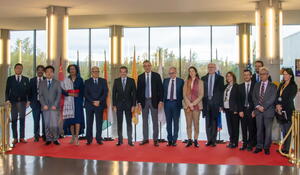“The beauty of international cooperation”
The IAEA Director General hails ITER as a steadying force in complex times.
Amid the effervescence of the private-sector fusion boom and the uncertainty of the global political climate, International Atomic Energy Agency (IAEA) Director General Rafael Grossi is urging ITER to continue to serve as a harmonizing element in the fusion world.
“There is a risk that fusion moves away from a cooperative phase into a geostrategic competition phase and this is something that must be avoided at all costs,” he said during an interview with Newsline. “We need the beauty of international cooperation that is at the heart of the ITER project.”
Director General Grossi made these comments on a visit to ITER on 13 November that included meetings with ITER Director-General Pietro Barbaschi, a tour of tokamak assembly, a talk to ITER staff, and an announcement that ITER and the neighboring CEA research centre will be hosting a session in 2026 of the IAEA Lise Meitner program (see box below).
“This visit is something that I have been really wanting to do for a long time and I can tell you, I haven’t been disappointed,” said Director General Grossi. “On the contrary, what I see here is a real turnaround that coincides with a special moment for fusion.”
Director General Grossi applauded ITER for having successfully navigated the technical problems that led to the adoption of the new baseline and said international organizations like ITER and the IAEA must thrive in the context of the “polarity between conflict and cooperation that is inherent to humanity.”
The IAEA has played a historic role in the ITER project—one that Director General Grossi likened to “being a midwife.” With the immense flow of investment into fusion and the rapid rise in the number of private-sector fusion companies, he says that ITER has an important function in providing concrete scientific and engineering expertise and in facilitating dialogue between the different approaches to solving the fusion puzzle. “ITER infrastructure, and what it’s going to allow in terms of discovery and demonstration as we move on to fusion energy production, is unique!”




